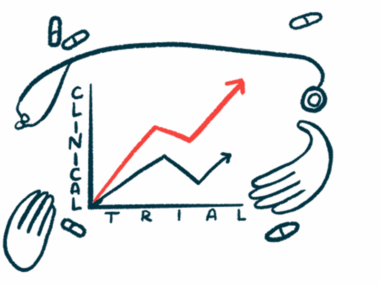RXR agonist, IRX4204, safely eases motor symptoms in Phase 1 trial
Oral therapy given to 15 adults with early Parkinson's, further studies planned
Written by |

Once-daily treatment with IRX4204, an oral small molecule being developed by Io Therapeutics, showed a potential to safely ease motor symptoms for most adults with early Parkinson’s disease taking part in a small, 30-day study.
Building on this open-label Phase 1 clinical trial (NCT02438215), the company plans to initiate a Phase 2 study later this year to compare IRX4204’s safety and efficacy against a placebo in Parkinson’s patients.
IRX4204 also is being explored as a potential treatment for various types of cancer, and for neurodegeneration associated with normal aging, Alzheimer’s disease, and other neurological conditions where inflammation is known to play a role.
In clinical trials, including those involving cancer patients, IRX4204 “was well-tolerated for up to 20 months of continuous oral treatment,” scientists reported.
RXR agonists are seen as possibly protecting dopaminergic neurons
“IRX4204 has been safe and well tolerated in patients and has potential to be an effective monotherapy [on its own] for [the] prevention or treatment of debilitating neurologic manifestations,” Martin E. Sanders, MD, Io’s CEO, said in a company press release.
Clinical trial and lab study findings were shared alongside insights into IRX4204’s mechanism of action in the oral presentation, “The highly potent and selective RXR agonist compound IRX4204 is a potential treatment for normal aging-related neurodegeneration, Parkinson’s disease (PD), and Alzheimer’s disease (AD).” It was given at the Federation of American Societies for Experimental Biology (FASEB) seventh retinoids conference, held July 7-11 in Saint Paul, Minnesota.
Parkinson’s motor symptoms are a result of the degeneration of dopaminergic neurons, nerve cells responsible for producing dopamine, a neurotransmitter essential for motor control. Mounting evidence indicates that medications activating retinoid X receptors (RXRs), referred to as RXR agonists, may promote dopaminergic neuronal survival and enhance their function.
RXRs are found within cells and play an important role in regulating the activity of different genes, acting as a switch that can be turned on or off to control certain cellular functions.
IRX4204 is an RXR agonist that can cross the blood-brain barrier, the semi-permeable membrane that keeps harmful substances from reaching the brain. This barrier, however, also can prevent potentially helpful medications from making it through and acting where they are needed.
In addition to being an RXR agonist, IRX4204 activates Nurr1, a target for experimental medications that may be disease-modifying Parkinson’s treatments. Nurr1 signaling is key for dopaminergic neurons’ survival and function.
In preclinical studies in human cells, IRX4204 increased the number of regulatory T-cells, a type of immune cell the keeps inflammation under control.
13 of 15 Parkinson’s patients showed gains on motor tests with treatment
Likewise, in animal models, IRX4204 was seen to inhibit the production of inflammatory molecules by microglia, the brain’s primary immune cells. When used alone or in combination with insulin or thyroid hormone, IRX4204 also prolonged survival and promoted the growth of neurites, cell extensions that help neurons connect and communicate with other cells, the company reported.
“We believe multi-agent combination treatments including IRX4204 will enable development of well tolerated, highly effective preventative and therapeutic interventions for diverse types of neurodegenerative diseases,” Sanders said.
In a rat model of Parkinson’s, daily treatment with IRX4204 reduced the loss of dopaminergic neurons compared with a placebo. Treated rats also were seen to move their forelimbs more symmetrically and spontaneously than those given a placebo when the animals were placed in a glass cylinder.
In the Phase 1 clinical trial, 15 people diagnosed with early Parkinson’s disease, ages 40 to 80, were treated for 30 days with once daily IRX4204, given as a gel capsule at doses of 5, 10, or 20 mg. All also were receiving standard Parkinson’s treatments.
Trial researchers watched for changes in motor and nonmotor disease symptoms with the treatment’s start using the Movement Disorders Society-Unified Parkinson’s Disease Rating Scale (MDS-UPDRS). On this scale, higher scores indicate more severe symptoms.
On average, MDS-UPDRS scores fell by up to 18.7% after two weeks of IRX4204’s use, indicating an overall improvement. Of the 15 patients, 13 showed an improvement in total motor scores, with reductions ranging from 11.7% to 31.4%, the company reported.
To date, 100 people have been treated with IRX4204 in clinical trials: 85 with various types of cancer and the 15 early Parkinson’s patients.
IRX4204 has been well tolerated and “demonstrated safety and tolerability of oral dosing in phase I and II clinical trials … for up to 20 months,” the researchers concluded in their presentation.






